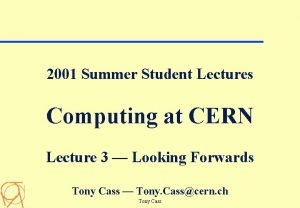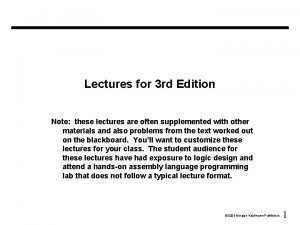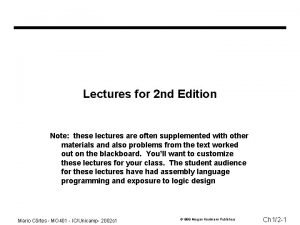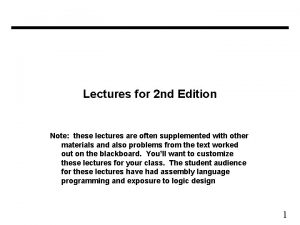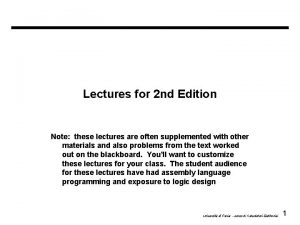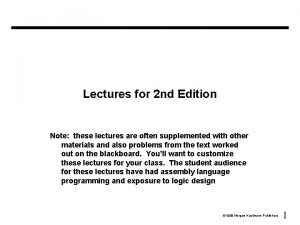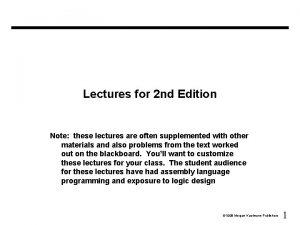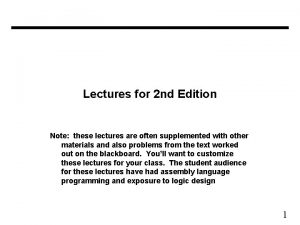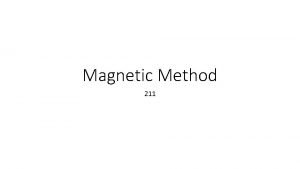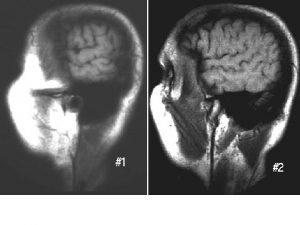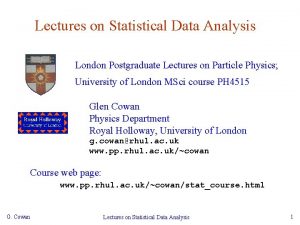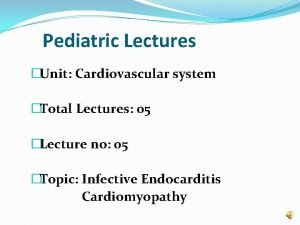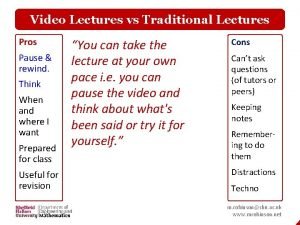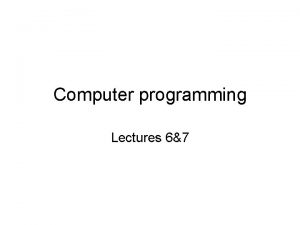Lectures for 2 nd Edition Note these lectures





































![Instructions • • Load and store instructions Example: C code: A[8] = h + Instructions • • Load and store instructions Example: C code: A[8] = h +](https://slidetodoc.com/presentation_image_h2/97c05e92452ddc2ae0e9c28aaae938d3/image-38.jpg)
![Our First Example • Can we figure out the code? swap(int v[], int k); Our First Example • Can we figure out the code? swap(int v[], int k);](https://slidetodoc.com/presentation_image_h2/97c05e92452ddc2ae0e9c28aaae938d3/image-39.jpg)






















































- Slides: 93

Lectures for 2 nd Edition Note: these lectures are often supplemented with other materials and also problems from the text worked out on the blackboard. You’ll want to customize these lectures for your class. The student audience for these lectures have had assembly language programming and exposure to logic design 1

Chapter 1 2

Introduction • Rapidly changing field: – vacuum tube -> transistor -> IC -> VLSI (see section 1. 4) – doubling every 1. 5 years: memory capacity processor speed (Due to advances in technology and organization) • Things you’ll be learning: – how computers work, a basic foundation – how to analyze their performance (or how not to!) – issues affecting modern processors (caches, pipelines) • Why learn this stuff? – you want to call yourself a “computer scientist” – you want to build software people use (need performance) – you need to make a purchasing decision or offer “expert” advice 3

What is a computer? • • Components: – input (mouse, keyboard) – output (display, printer) – memory (disk drives, DRAM, SRAM, CD) – network Our primary focus: the processor (datapath and control) – implemented using millions of transistors – Impossible to understand by looking at each transistor – We need. . . 4

Abstraction • Delving into the depths reveals more information • An abstraction omits unneeded detail, helps us cope with complexity What are some of the details that appear in these familiar abstractions? 5

Instruction Set Architecture • A very important abstraction – interface between hardware and low-level software – standardizes instructions, machine language bit patterns, etc. – advantage: different implementations of the same architecture – disadvantage: sometimes prevents using new innovations True or False: Binary compatibility is extraordinarily important? • Modern instruction set architectures: – 80 x 86/Pentium/K 6, Power. PC, DEC Alpha, MIPS, SPARC, HP 6

Where we are headed • • Performance issues (Chapter 2) vocabulary and motivation A specific instruction set architecture (Chapter 3) Arithmetic and how to build an ALU (Chapter 4) Constructing a processor to execute our instructions (Chapter 5) Pipelining to improve performance (Chapter 6) Memory: caches and virtual memory (Chapter 7) I/O (Chapter 8) Key to a good grade: reading the book! 7

Chapter 2 8

Performance • • Measure, Report, and Summarize Make intelligent choices See through the marketing hype Key to understanding underlying organizational motivation Why is some hardware better than others for different programs? What factors of system performance are hardware related? (e. g. , Do we need a new machine, or a new operating system? ) How does the machine's instruction set affect performance? 9

Which of these airplanes has the best performance? Airplane Passengers Boeing 737 -100 Boeing 747 BAC/Sud Concorde Douglas DC-8 -50 101 470 132 146 Range (mi) Speed (mph) 630 4150 4000 8720 598 610 1350 544 • How much faster is the Concorde compared to the 747? • How much bigger is the 747 than the Douglas DC-8? 10

Computer Performance: TIME, TIME • Response Time (latency) — How long does it take for my job to run? — How long does it take to execute a job? — How long must I wait for the database query? • Throughput — How many jobs can the machine run at once? — What is the average execution rate? — How much work is getting done? • If we upgrade a machine with a new processor what do we increase? If we add a new machine to the lab what do we increase? 11

Execution Time • • • Elapsed Time – counts everything (disk and memory accesses, I/O , etc. ) – a useful number, but often not good for comparison purposes CPU time – doesn't count I/O or time spent running other programs – can be broken up into system time, and user time Our focus: user CPU time – time spent executing the lines of code that are "in" our program 12

Book's Definition of Performance • For some program running on machine X, Performance. X = 1 / Execution time. X • "X is n times faster than Y" Performance. X / Performance. Y = n • Problem: – machine A runs a program in 20 seconds – machine B runs the same program in 25 seconds 13

Clock Cycles • Instead of reporting execution time in seconds, we often use cycles • Clock “ticks” indicate when to start activities (one abstraction): time • • cycle time = time between ticks = seconds per cycle clock rate (frequency) = cycles per second (1 Hz. = 1 cycle/sec) A 200 Mhz. clock has a cycle time 14

How to Improve Performance So, to improve performance (everything else being equal) you can either ____ the # of required cycles for a program, or ____ the clock cycle time or, said another way, ____ the clock rate. 15

How many cycles are required for a program? . . . 6 th 5 th 4 th 3 rd instruction 2 nd instruction Could assume that # of cycles = # of instructions 1 st instruction • time This assumption is incorrect, different instructions take different amounts of time on different machines. Why? hint: remember that these are machine instructions, not lines of C code 16

Different numbers of cycles for different instructions time • Multiplication takes more time than addition • Floating point operations take longer than integer ones • Accessing memory takes more time than accessing registers • Important point: changing the cycle time often changes the number of cycles required for various instructions (more later) 17

Example • Our favorite program runs in 10 seconds on computer A, which has a 400 Mhz. clock. We are trying to help a computer designer build a new machine B, that will run this program in 6 seconds. The designer can use new (or perhaps more expensive) technology to substantially increase the clock rate, but has informed us that this increase will affect the rest of the CPU design, causing machine B to require 1. 2 times as many clock cycles as machine A for the same program. What clock rate should we tell the designer to target? " • Don't Panic, can easily work this out from basic principles 18

Now that we understand cycles • A given program will require – some number of instructions (machine instructions) – some number of cycles – some number of seconds • We have a vocubulary that relates these quantities: – cycle time (seconds per cycle) – clock rate (cycles per second) – CPI (cycles per instruction) a floating point intensive application might have a higher CPI – MIPS (millions of instructions per second) this would be higher for a program using simple instructions 19

Performance • • Performance is determined by execution time Do any of the other variables equal performance? – # of cycles to execute program? – # of instructions in program? – # of cycles per second? – average # of cycles per instruction? – average # of instructions per second? • Common pitfall: thinking one of the variables is indicative of performance when it really isn’t. 20

CPI Example • Suppose we have two implementations of the same instruction set architecture (ISA). For some program, Machine A has a clock cycle time of 10 ns. and a CPI of 2. 0 Machine B has a clock cycle time of 20 ns. and a CPI of 1. 2 What machine is faster for this program, and by how much? • If two machines have the same ISA which of our quantities (e. g. , clock rate, CPI, execution time, # of instructions, MIPS) will always be identical? 21

# of Instructions Example • A compiler designer is trying to decide between two code sequences for a particular machine. Based on the hardware implementation, there are three different classes of instructions: Class A, Class B, and Class C, and they require one, two, and three cycles (respectively). The first code sequence has 5 instructions: 2 of A, 1 of B, and 2 of C The second sequence has 6 instructions: 4 of A, 1 of B, and 1 of C. Which sequence will be faster? How much? What is the CPI for each sequence? 22

MIPS (Million Instructions Per Second) example • Two different compilers are being tested for a 500 MHz. machine with three different classes of instructions: Class A, Class B, and Class C, which require one, two, and three cycles (respectively). Both compilers are used to produce code for a large piece of software. The first compiler's code uses 5 billions Class A instructions, 1 billion Class B instructions, and 1 billion Class C instructions. The second compiler's code uses 10 billion Class A instructions, 1 billion Class B instructions, and 1 billion Class C instructions. • • Which sequence will be faster according to MIPS? Which sequence will be faster according to execution time? 23

Benchmarks • • • Performance best determined by running a real application – Use programs typical of expected workload – Or, typical of expected class of applications e. g. , compilers/editors, scientific applications, graphics, etc. Small benchmarks – nice for architects and designers – easy to standardize – can be abused SPEC (System Performance Evaluation Cooperative) – companies have agreed on a set of real program and inputs – can still be abused (Intel’s “other” bug) – valuable indicator of performance (and compiler technology) 24

SPEC ‘ 89 • Compiler “enhancements” and performance 25

SPEC ‘ 95 26

SPEC ‘ 95 Does doubling the clock rate double the performance? Can a machine with a slower clock rate have better performance? 27

Amdahl's Law Execution Time After Improvement = Execution Time Unaffected +( Execution Time Affected / Amount of Improvement ) • Example: "Suppose a program runs in 100 seconds on a machine, with multiply responsible for 80 seconds of this time. How much do we have to improve the speed of multiplication if we want the program to run 4 times faster? " How about making it 5 times faster? • Principle: Make the common case fast 28

Example • Suppose we enhance a machine making all floating-point instructions run five times faster. If the execution time of some benchmark before the floatingpoint enhancement is 10 seconds, what will the speedup be if half of the 10 seconds is spent executing floating-point instructions? • We are looking for a benchmark to show off the new floating-point unit described above, and want the overall benchmark to show a speedup of 3. One benchmark we are considering runs for 100 seconds with the old floating -point hardware. How much of the execution time would floating-point instructions have to account for in this program in order to yield our desired speedup on this benchmark? 29

Remember • Performance is specific to a particular program/s – Total execution time is a consistent summary of performance • For a given architecture performance increases come from: – increases in clock rate (without adverse CPI affects) – improvements in processor organization that lower CPI – compiler enhancements that lower CPI and/or instruction count • Pitfall: expecting improvement in one aspect of a machine’s performance to affect the total performance • You should not always believe everything you read! Read carefully! (see newspaper articles, e. g. , Exercise 2. 37) 30

Chapter 3 31

Instructions: • • Language of the Machine More primitive than higher level languages e. g. , no sophisticated control flow Very restrictive e. g. , MIPS Arithmetic Instructions We’ll be working with the MIPS instruction set architecture – similar to other architectures developed since the 1980's – used by NEC, Nintendo, Silicon Graphics, Sony Design goals: maximize performance and minimize cost, reduce design time 32

MIPS arithmetic • • All instructions have 3 operands Operand order is fixed (destination first) Example: C code: A = B + C MIPS code: add $s 0, $s 1, $s 2 (associated with variables by compiler) 33

MIPS arithmetic • • Design Principle: simplicity favors regularity. Of course this complicates some things. . . C code: A = B + C + D; E = F - A; MIPS code: add $t 0, $s 1, $s 2 add $s 0, $t 0, $s 3 sub $s 4, $s 5, $s 0 Why? Operands must be registers, only 32 registers provided Design Principle: smaller is faster. Why? 34

Registers vs. Memory • • • Arithmetic instructions operands must be registers, — only 32 registers provided Compiler associates variables with registers What about programs with lots of variables Control Input Memory Datapath Processor Output I/O 35

Memory Organization • • • Viewed as a large, single-dimension array, with an address. A memory address is an index into the array "Byte addressing" means that the index points to a byte of memory. 0 1 2 3 4 5 6. . . 8 bits of data 8 bits of data 36

Memory Organization • • • Bytes are nice, but most data items use larger "words" For MIPS, a word is 32 bits or 4 bytes. 0 32 bits of data 4 32 bits of data Registers hold 32 bits of data 8 32 bits of data 12 32 bits of data. . . 232 bytes with byte addresses from 0 to 232 -1 230 words with byte addresses 0, 4, 8, . . . 232 -4 Words are aligned i. e. , what are the least 2 significant bits of a word address? 37
![Instructions Load and store instructions Example C code A8 h Instructions • • Load and store instructions Example: C code: A[8] = h +](https://slidetodoc.com/presentation_image_h2/97c05e92452ddc2ae0e9c28aaae938d3/image-38.jpg)
Instructions • • Load and store instructions Example: C code: A[8] = h + A[8]; MIPS code: lw $t 0, 32($s 3) add $t 0, $s 2, $t 0 sw $t 0, 32($s 3) Store word has destination last Remember arithmetic operands are registers, not memory! 38
![Our First Example Can we figure out the code swapint v int k Our First Example • Can we figure out the code? swap(int v[], int k);](https://slidetodoc.com/presentation_image_h2/97c05e92452ddc2ae0e9c28aaae938d3/image-39.jpg)
Our First Example • Can we figure out the code? swap(int v[], int k); { int temp; temp = v[k] = v[k+1]; v[k+1] = temp; swap: } muli $2, $5, 4 add $2, $4, $2 lw $15, 0($2) lw $16, 4($2) sw $16, 0($2) sw $15, 4($2) jr $31 39

So far we’ve learned: • MIPS — loading words but addressing bytes — arithmetic on registers only • Instruction Meaning add $s 1, $s 2, $s 3 sub $s 1, $s 2, $s 3 lw $s 1, 100($s 2) sw $s 1, 100($s 2) $s 1 = $s 2 + $s 3 $s 1 = $s 2 – $s 3 $s 1 = Memory[$s 2+100] = $s 1 40

Machine Language • Instructions, like registers and words of data, are also 32 bits long – Example: add $t 0, $s 1, $s 2 – registers have numbers, $t 0=9, $s 1=17, $s 2=18 • Instruction Format: 000000 10001 10010 01000 00000 100000 op • rs rt rd shamt funct Can you guess what the field names stand for? 41

Machine Language • • Consider the load-word and store-word instructions, – What would the regularity principle have us do? – New principle: Good design demands a compromise Introduce a new type of instruction format – I-type for data transfer instructions – other format was R-type for register Example: lw $t 0, 32($s 2) 35 18 9 op rs rt 32 16 bit number Where's the compromise? 42

Stored Program Concept • • Instructions are bits Programs are stored in memory — to be read or written just like data Processor • Memory memory for data, programs, compilers, editors, etc. Fetch & Execute Cycle – Instructions are fetched and put into a special register – Bits in the register "control" the subsequent actions – Fetch the “next” instruction and continue 43

Control • Decision making instructions – alter the control flow, – i. e. , change the "next" instruction to be executed • MIPS conditional branch instructions: bne $t 0, $t 1, Label beq $t 0, $t 1, Label • Example: if (i==j) h = i + j; bne $s 0, $s 1, Label add $s 3, $s 0, $s 1 Label: . . 44

Control • MIPS unconditional branch instructions: j label • Example: if (i!=j) h=i+j; else h=i-j; • beq $s 4, $s 5, Lab 1 add $s 3, $s 4, $s 5 j Lab 2 Lab 1: sub $s 3, $s 4, $s 5 Lab 2: . . . Can you build a simple for loop? 45

So far: • • Instruction Meaning add $s 1, $s 2, $s 3 sub $s 1, $s 2, $s 3 lw $s 1, 100($s 2) sw $s 1, 100($s 2) bne $s 4, $s 5, L beq $s 4, $s 5, L j Label $s 1 = $s 2 + $s 3 $s 1 = $s 2 – $s 3 $s 1 = Memory[$s 2+100] = $s 1 Next instr. is at Label if $s 4 ° $s 5 Next instr. is at Label if $s 4 = $s 5 Next instr. is at Label Formats: R op rs rt rd I op rs rt 16 bit address J op shamt funct 26 bit address 46

Control Flow • • We have: beq, bne, what about Branch-if-less-than? New instruction: if $s 1 < $s 2 then $t 0 = 1 slt $t 0, $s 1, $s 2 else $t 0 = 0 • Can use this instruction to build "blt $s 1, $s 2, Label" — can now build general control structures Note that the assembler needs a register to do this, — there are policy of use conventions for registers • 47 2

Policy of Use Conventions 48

Constants • • • Small constants are used quite frequently (50% of operands) e. g. , A = A + 5; B = B + 1; C = C - 18; Solutions? Why not? – put 'typical constants' in memory and load them. – create hard-wired registers (like $zero) for constants like one. MIPS Instructions: addi $29, 4 slti $8, $18, 10 andi $29, 6 ori $29, 4 • How do we make this work? 49 3

How about larger constants? • • We'd like to be able to load a 32 bit constant into a register Must use two instructions, new "load upper immediate" instruction lui $t 0, 1010101010101010 • filled with zeros 00000000 Then must get the lower order bits right, i. e. , ori $t 0, 10101010 ori 10101010 0000000000000000 1010101010101010 50

Assembly Language vs. Machine Language • • Assembly provides convenient symbolic representation – much easier than writing down numbers – e. g. , destination first Machine language is the underlying reality – e. g. , destination is no longer first Assembly can provide 'pseudoinstructions' – e. g. , “move $t 0, $t 1” exists only in Assembly – would be implemented using “add $t 0, $t 1, $zero” When considering performance you should count real instructions 51

Other Issues • • • Things we are not going to cover support for procedures linkers, loaders, memory layout stacks, frames, recursion manipulating strings and pointers interrupts and exceptions system calls and conventions Some of these we'll talk about later We've focused on architectural issues – basics of MIPS assembly language and machine code – we’ll build a processor to execute these instructions. 52

Overview of MIPS • • • simple instructions all 32 bits wide very structured, no unnecessary baggage only three instruction formats R op rs rt rd I op rs rt 16 bit address J op shamt funct 26 bit address rely on compiler to achieve performance — what are the compiler's goals? help compiler where we can 53

Addresses in Branches and Jumps • • • Instructions: bne $t 4, $t 5, Label beq $t 4, $t 5, Label j Label Next instruction is at Label if $t 4 ° $t 5 Next instruction is at Label if $t 4 = $t 5 Next instruction is at Label Formats: I op J op rs rt 16 bit address 26 bit address Addresses are not 32 bits — How do we handle this with load and store instructions? 54

Addresses in Branches • • Instructions: bne $t 4, $t 5, Label beq $t 4, $t 5, Label Formats: I • • Next instruction is at Label if $t 4°$t 5 Next instruction is at Label if $t 4=$t 5 op rs rt 16 bit address Could specify a register (like lw and sw) and add it to address – use Instruction Address Register (PC = program counter) – most branches are local (principle of locality) Jump instructions just use high order bits of PC – address boundaries of 256 MB 55

To summarize: 56

57

Alternative Architectures • Design alternative: – provide more powerful operations – goal is to reduce number of instructions executed – danger is a slower cycle time and/or a higher CPI • Sometimes referred to as “RISC vs. CISC” – virtually all new instruction sets since 1982 have been RISC – VAX: minimize code size, make assembly language easy instructions from 1 to 54 bytes long! • We’ll look at Power. PC and 80 x 86 58

Power. PC • Indexed addressing – example: lw $t 1, $a 0+$s 3 #$t 1=Memory[$a 0+$s 3] – What do we have to do in MIPS? • • Update addressing – update a register as part of load (for marching through arrays) – example: lwu $t 0, 4($s 3) #$t 0=Memory[$s 3+4]; $s 3=$s 3+4 – What do we have to do in MIPS? Others: – load multiple/store multiple – a special counter register “bc Loop” decrement counter, if not 0 goto loop 59

80 x 86 • • • 1978: The Intel 8086 is announced (16 bit architecture) 1980: The 8087 floating point coprocessor is added 1982: The 80286 increases address space to 24 bits, +instructions 1985: The 80386 extends to 32 bits, new addressing modes 1989 -1995: The 80486, Pentium Pro add a few instructions (mostly designed for higher performance) 1997: MMX is added “This history illustrates the impact of the “golden handcuffs” of compatibility “adding new features as someone might add clothing to a packed bag” “an architecture that is difficult to explain and impossible to love” 60

A dominant architecture: 80 x 86 • • • See your textbook for a more detailed description Complexity: – Instructions from 1 to 17 bytes long – one operand must act as both a source and destination – one operand can come from memory – complex addressing modes e. g. , “base or scaled index with 8 or 32 bit displacement” Saving grace: – the most frequently used instructions are not too difficult to build – compilers avoid the portions of the architecture that are slow “what the 80 x 86 lacks in style is made up in quantity, making it beautiful from the right perspective” 61

Summary • • • Instruction complexity is only one variable – lower instruction count vs. higher CPI / lower clock rate Design Principles: – simplicity favors regularity – smaller is faster – good design demands compromise – make the common case fast Instruction set architecture – a very important abstraction indeed! 62

Chapter Four 63

Arithmetic • • Where we've been: – Performance (seconds, cycles, instructions) – Abstractions: Instruction Set Architecture Assembly Language and Machine Language What's up ahead: – Implementing the Architecture operation a 32 ALU result 32 b 32 64

Numbers • • Bits are just bits (no inherent meaning) — conventions define relationship between bits and numbers Binary numbers (base 2) 0000 0001 0010 0011 0100 0101 0110 0111 1000 1001. . . decimal: 0. . . 2 n-1 Of course it gets more complicated: numbers are finite (overflow) fractions and real numbers negative numbers e. g. , no MIPS subi instruction; addi can add a negative number) How do we represent negative numbers? i. e. , which bit patterns will represent which numbers? 65

Possible Representations • Sign Magnitude: 000 = +0 001 = +1 010 = +2 011 = +3 100 = -0 101 = -1 110 = -2 111 = -3 • • One's Complement Two's Complement 000 = +0 001 = +1 010 = +2 011 = +3 100 = -3 101 = -2 110 = -1 111 = -0 000 = +0 001 = +1 010 = +2 011 = +3 100 = -4 101 = -3 110 = -2 111 = -1 Issues: balance, number of zeros, ease of operations Which one is best? Why? 66

MIPS • 32 bit signed numbers: 0000. . . 0111 1000. . . 1111 0000 0000 two = 0 ten 0000 0000 0001 two = + 1 ten 0000 0000 0010 two = + 2 ten 1111 1111 0000 0000 0000 1111 0000 0000 1110 two 1111 two 0000 two 0001 two 0010 two = = = + + – – – 2, 147, 483, 646 ten 2, 147, 483, 647 ten 2, 147, 483, 648 ten 2, 147, 483, 647 ten 2, 147, 483, 646 ten maxint minint 1111 1111 1101 two = – 3 ten 1111 1111 1110 two = – 2 ten 1111 1111 two = – 1 ten 67

Two's Complement Operations • Negating a two's complement number: invert all bits and add 1 – remember: “negate” and “invert” are quite different! • Converting n bit numbers into numbers with more than n bits: – MIPS 16 bit immediate gets converted to 32 bits for arithmetic – copy the most significant bit (the sign bit) into the other bits 0010 -> 0000 0010 1010 -> 1111 1010 – "sign extension" (lbu vs. lb) 68

Addition & Subtraction • Just like in grade school (carry/borrow 1 s) 0111 0110 + 0110 - 0101 • Two's complement operations easy – subtraction using addition of negative numbers 0111 + 1010 • Overflow (result too large for finite computer word): – e. g. , adding two n-bit numbers does not yield an n-bit number 0111 + 0001 note that overflow term is somewhat misleading, 1000 it does not mean a carry “overflowed” 69

Detecting Overflow • • No overflow when adding a positive and a negative number No overflow when signs are the same for subtraction Overflow occurs when the value affects the sign: – overflow when adding two positives yields a negative – or, adding two negatives gives a positive – or, subtract a negative from a positive and get a negative – or, subtract a positive from a negative and get a positive Consider the operations A + B, and A – B – Can overflow occur if B is 0 ? – Can overflow occur if A is 0 ? 70

Effects of Overflow • • • An exception (interrupt) occurs – Control jumps to predefined address for exception – Interrupted address is saved for possible resumption Details based on software system / language – example: flight control vs. homework assignment Don't always want to detect overflow — new MIPS instructions: addu, addiu, subu note: addiu still sign-extends! note: sltu, sltiu for unsigned comparisons 71

Review: Boolean Algebra & Gates • Problem: Consider a logic function with three inputs: A, B, and C. Output D is true if at least one input is true Output E is true if exactly two inputs are true Output F is true only if all three inputs are true • Show the truth table for these three functions. • Show the Boolean equations for these three functions. • Show an implementation consisting of inverters, AND, and OR gates. 72

An ALU (arithmetic logic unit) • Let's build an ALU to support the andi and ori instructions – we'll just build a 1 bit ALU, and use 32 of them operation a op a b result b • Possible Implementation (sum-of-products): 73

Review: The Multiplexor • Selects one of the inputs to be the output, based on a control input S • A 0 B 1 C note: we call this a 2 -input mux even though it has 3 inputs! Lets build our ALU using a MUX: 74

Different Implementations • Not easy to decide the “best” way to build something – Don't want too many inputs to a single gate – Dont want to have to go through too many gates – for our purposes, ease of comprehension is important • Let's look at a 1 -bit ALU for addition: cout = a b + a cin + b cin sum = a xor b xor cin • How could we build a 1 -bit ALU for add, and or? • How could we build a 32 -bit ALU? 75

Building a 32 bit ALU 76

What about subtraction (a – b) ? • • Two's complement approch: just negate b and add. How do we negate? • A very clever solution: 77

Tailoring the ALU to the MIPS • Need to support the set-on-less-than instruction (slt) – remember: slt is an arithmetic instruction – produces a 1 if rs < rt and 0 otherwise – use subtraction: (a-b) < 0 implies a < b • Need to support test for equality (beq $t 5, $t 6, $t 7) – use subtraction: (a-b) = 0 implies a = b 78

Supporting slt • Can we figure out the idea?

80

Test for equality • Notice control lines: 000 001 010 111 = = = and or add subtract slt • Note: zero is a 1 when the result is zero! 81

Conclusion • We can build an ALU to support the MIPS instruction set – key idea: use multiplexor to select the output we want – we can efficiently perform subtraction using two’s complement – we can replicate a 1 -bit ALU to produce a 32 -bit ALU • Important points about hardware – all of the gates are always working – the speed of a gate is affected by the number of inputs to the gate – the speed of a circuit is affected by the number of gates in series (on the “critical path” or the “deepest level of logic”) • Our primary focus: comprehension, however, – Clever changes to organization can improve performance (similar to using better algorithms in software) – we’ll look at two examples for addition and multiplication 82

Problem: ripple carry adder is slow • • Is a 32 -bit ALU as fast as a 1 -bit ALU? Is there more than one way to do addition? – two extremes: ripple carry and sum-of-products Can you see the ripple? How could you get rid of it? c 1 c 2 c 3 c 4 = = b 0 c 0 b 1 c 1 b 2 c 2 b 3 c 3 + + a 0 c 0 a 1 c 1 a 2 c 2 a 3 c 3 + + a 0 b 0 a 1 b 1 c 2 = a 2 b 2 a 3 b 3 c 3 = c 4 = Not feasible! Why? 83

Carry-lookahead adder • • An approach in-between our two extremes Motivation: – If we didn't know the value of carry-in, what could we do? – When would we always generate a carry? gi = a i bi – When would we propagate the carry? pi = a i + b i • Did we get rid of the ripple? c 1 c 2 c 3 c 4 = = g 0 g 1 g 2 g 3 + + p 0 c 0 p 1 c 1 c 2 = p 2 c 2 c 3 = p 3 c 3 c 4 = Feasible! Why? 84

Use principle to build bigger adders • • • Can’t build a 16 bit adder this way. . . (too big) Could use ripple carry of 4 -bit CLA adders Better: use the CLA principle again! 85

Multiplication • • • More complicated than addition – accomplished via shifting and addition More time and more area Let's look at 3 versions based on gradeschool algorithm 0010 __x_1011 • (multiplicand) (multiplier) Negative numbers: convert and multiply – there are better techniques, we won’t look at them 86

Multiplication: Implementation 87

Second Version 88

Final Version 89

Floating Point (a brief look) • We need a way to represent – numbers with fractions, e. g. , 3. 1416 – very small numbers, e. g. , . 00001 – very large numbers, e. g. , 3. 15576 ´ 109 • Representation: – sign, exponent, significand: (– 1)sign ´ significand ´ 2 exponent – more bits for significand gives more accuracy – more bits for exponent increases range • IEEE 754 floating point standard: – single precision: 8 bit exponent, 23 bit significand – double precision: 11 bit exponent, 52 bit significand 90

IEEE 754 floating-point standard • Leading “ 1” bit of significand is implicit • Exponent is “biased” to make sorting easier – all 0 s is smallest exponent all 1 s is largest – bias of 127 for single precision and 1023 for double precision – summary: (– 1)sign ´ (1+significand) ´ 2 exponent – bias • Example: – decimal: -. 75 = -3/4 = -3/22 – binary: -. 11 = -1. 1 x 2 -1 – floating point: exponent = 126 = 01111110 – IEEE single precision: 101111110100000000000 91

Floating Point Complexities • Operations are somewhat more complicated (see text) • In addition to overflow we can have “underflow” • Accuracy can be a big problem – IEEE 754 keeps two extra bits, guard and round – four rounding modes – positive divided by zero yields “infinity” – zero divide by zero yields “not a number” • • – other complexities Implementing the standard can be tricky Not using the standard can be even worse – see text for description of 80 x 86 and Pentium bug! 92

Chapter Four Summary • • • Computer arithmetic is constrained by limited precision Bit patterns have no inherent meaning but standards do exist – two’s complement – IEEE 754 floating point Computer instructions determine “meaning” of the bit patterns Performance and accuracy are important so there are many complexities in real machines (i. e. , algorithms and implementation). We are ready to move on (and implement the processor) you may want to look back (Section 4. 12 is great reading!) 93
 What is debit note and credit note
What is debit note and credit note Signal wods
Signal wods Nota debit adalah
Nota debit adalah Difference between note making and note taking
Difference between note making and note taking Note making advantages
Note making advantages Goods received note
Goods received note Simple discount example
Simple discount example Difference between note making and note taking
Difference between note making and note taking Using mis (10th edition) 10th edition
Using mis (10th edition) 10th edition Using mis (10th edition)
Using mis (10th edition) Smärtskolan kunskap för livet
Smärtskolan kunskap för livet Typiska drag för en novell
Typiska drag för en novell Fimbrietratt
Fimbrietratt Frgar
Frgar Tallinjen
Tallinjen För och nackdelar med firo
För och nackdelar med firo Toppslätskivling effekt
Toppslätskivling effekt Adressändring ideell förening
Adressändring ideell förening Borra hål för knoppar
Borra hål för knoppar Redogör för vad psykologi är
Redogör för vad psykologi är Bris för vuxna
Bris för vuxna Mat för unga idrottare
Mat för unga idrottare Etik och ledarskap etisk kod för chefer
Etik och ledarskap etisk kod för chefer Publik sektor
Publik sektor Argument för teckenspråk som minoritetsspråk
Argument för teckenspråk som minoritetsspråk Ellika andolf
Ellika andolf Datorkunskap för nybörjare
Datorkunskap för nybörjare Mantel för kvinnor i antikens rom
Mantel för kvinnor i antikens rom Rita perspektiv
Rita perspektiv Ministerstyre för och nackdelar
Ministerstyre för och nackdelar Geometriska former i förskolan
Geometriska former i förskolan Tack för att ni lyssnade bild
Tack för att ni lyssnade bild Claes martinsson
Claes martinsson Sju principer för tillitsbaserad styrning
Sju principer för tillitsbaserad styrning Exempel på dikt
Exempel på dikt Nyckelkompetenser för livslångt lärande
Nyckelkompetenser för livslångt lärande Mästar lärling modellen
Mästar lärling modellen Tidbok för yrkesförare
Tidbok för yrkesförare Orubbliga rättigheter
Orubbliga rättigheter Jätte råtta
Jätte råtta Verktyg för automatisering av utbetalningar
Verktyg för automatisering av utbetalningar Kolposkopi, px
Kolposkopi, px Kyssande vind
Kyssande vind Kanaans land
Kanaans land Ro i rom pax
Ro i rom pax Tack för att ni lyssnade bild
Tack för att ni lyssnade bild Strategi för svensk viltförvaltning
Strategi för svensk viltförvaltning Ledningssystem för verksamhetsinformation
Ledningssystem för verksamhetsinformation Tack för att ni har lyssnat
Tack för att ni har lyssnat Borstål, egenskaper
Borstål, egenskaper Vishnuiter
Vishnuiter Ekologiskt fotavtryck
Ekologiskt fotavtryck Centrum för kunskap och säkerhet
Centrum för kunskap och säkerhet Läkarutlåtande för livränta
Läkarutlåtande för livränta Påbyggnader för flakfordon
Påbyggnader för flakfordon Inköpsprocessen steg för steg
Inköpsprocessen steg för steg Sura för anatom
Sura för anatom Egg för emanuel
Egg för emanuel Variansen formel
Variansen formel Rutin för avvikelsehantering
Rutin för avvikelsehantering Klassificeringsstruktur för kommunala verksamheter
Klassificeringsstruktur för kommunala verksamheter Myndigheten för delaktighet
Myndigheten för delaktighet Presentera för publik crossboss
Presentera för publik crossboss Formuö
Formuö Tack för att ni lyssnade
Tack för att ni lyssnade Debatt mall
Debatt mall En lathund för arbete med kontinuitetshantering
En lathund för arbete med kontinuitetshantering Tobinskatten för och nackdelar
Tobinskatten för och nackdelar Referatmarkeringar
Referatmarkeringar Atmosfr
Atmosfr Meios steg för steg
Meios steg för steg Varför kallas perioden 1918-1939 för mellankrigstiden
Varför kallas perioden 1918-1939 för mellankrigstiden Lågenergihus nyproduktion
Lågenergihus nyproduktion Start för skala
Start för skala Formel för lufttryck
Formel för lufttryck Rbk-mätning
Rbk-mätning Densitet vatten
Densitet vatten Elektronik för barn
Elektronik för barn Var 1721 för stormaktssverige
Var 1721 för stormaktssverige Tack för att ni har lyssnat
Tack för att ni har lyssnat Medical student hematology lectures
Medical student hematology lectures Yelena bogdan
Yelena bogdan Lectures paediatrics
Lectures paediatrics Slagle lecture
Slagle lecture Nuclear medicine lectures
Nuclear medicine lectures Digital logic design lectures
Digital logic design lectures Introduction to recursion
Introduction to recursion Pathology lectures for medical students
Pathology lectures for medical students Cs614 short lectures
Cs614 short lectures Reinforcement learning lectures
Reinforcement learning lectures C programming lectures
C programming lectures Power system lectures
Power system lectures How to get the most out of lectures
How to get the most out of lectures Cern summer school lectures
Cern summer school lectures





























































































